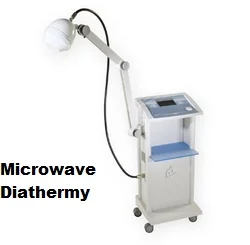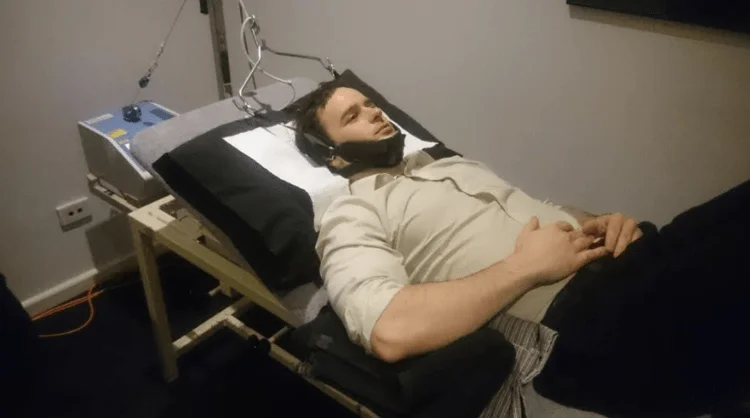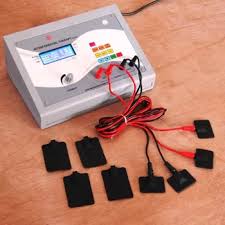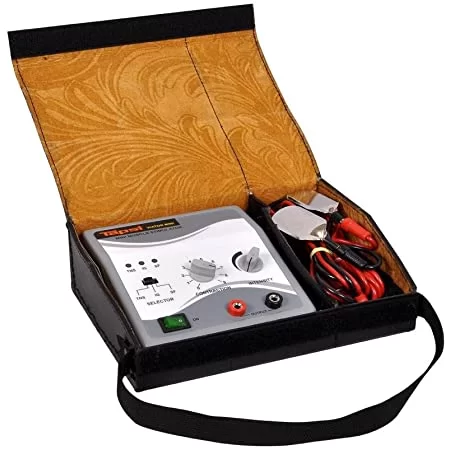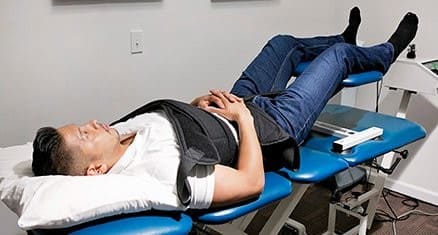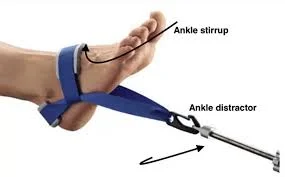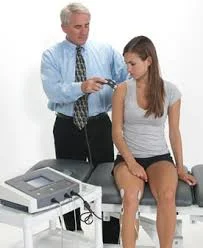Microwave Diathermy (MWD)
What is a Microwave Diathermy?
Microwave diathermy is a therapeutic modality used in physical therapy to deliver deep heat to tissues in the body. Utilizing microwave frequencies, typically in the range of 915 MHz to 2450 MHz, this treatment method is designed to provide pain relief, enhance tissue healing, and improve mobility.
Microwave diathermy works by generating electromagnetic waves that penetrate the skin and are absorbed by tissues, leading to molecular vibration and the production of heat. This heating effect can reach deeper tissues compared to other forms of diathermy such as shortwave or ultrasound, making it particularly effective for treating musculoskeletal conditions.
The region of the electromagnetic spectrum that contains microwaves has wavelengths ranging from 1 mm to 1 m. Medical frequencies range from 300 Mhz to 300 Ghz, as seen below.
The ranges of frequencies are 122.1 cm for 2450 MHZ, 32.8 cm for 915 MHz, as well as 69.1 cm for 434 MHz.
Although the frequency of therapeutic microwave diathermy varies by country, the heating impact of microwaves is universally recognized in microwave ovens used for cooking.
Microwaves can be used to treat musculoskeletal disorders by heating the tissue. They travel at the speed of light and follow the laws of reflection, refraction, absorption, and the inverse square law.
The rules of reflection
The law of reflection states that the angle at which a ray emerges from an irregular surface is exactly equal to the angle at which the tip of the reflected ray is reflected with respect to the surface’s corresponding surface line at the area of contact.
Together with the perpendicular surface, the impact ray determines the plane on which its representation is always positioned at the point of contact.
Rules of refraction
Refraction happens when electromagnetic rays are transported from one medium to another with an angle of incidence larger than zero.
Laws of Absorption
When electromagnetic rays reach a new medium, they can be absorbed and cause an effect. Rays’ absorption on the surface is contingent upon the wavelength, medium, and incidence angle.
Absorption is a material that absorbs certain electromagnetic waves and allows other waves to pass. Window glass enables visible light and infrared rays to pass while absorbing ultraviolet rays. A mobile absorbs short ultraviolet rays and allows long waves to pass.
Inverse Square Law
The effectiveness of light in relation to the distance away from the light source is described by the inverse square law.
The ratio of the square of the measurement of distance between the source and the observer determines how much light reaching the viewer.
Microwaves accept the rules of radiation because the director is situated a small fixed distance of 2 to 6 cm from the body.
The effects of reflection, penetration, and absorption are quite minor.
Microwaves follow the inverse square law, which stipulates that the intensity of radiation on the body’s surface should be considered while determining the skin director’s distance during patient treatment.
Production of Microwave Diathermy:
The incredibly high frequency of microwave diathermy is achieved not from transformers, oscillators, and related electrical components, but rather from the employment of the unique equipment known as a magnetron.
The magnetron generates an oscillating current directly from high-velocity electron movement.Electrons traverse the tiny holes in the donut-shaped structure of the magnetron, much like air is pushed over the top of an empty bottle. This results in a frequency response that is dependent on both the force and the velocity that drives the electron flow.
The current is created by high-velocity electron movement and attached together with a coaxial wire to the antenna or emitter that emits microwaves.
The dimensions of the coaxial cable are designed to offer an appropriate capacitance, allowing microwaves of the specified frequency to be delivered to the emitter with optimum efficiency. To focus a microwave beam in a single direction, an appropriately sized and shaped piece of wire is positioned in front of the metal reflection as the antenna.
the output of the microwave energy can be controlled by changing the power supplied to the magnetron, thus the machine has an intensity control, and the output is indicated on the meter, the meter does not tell about the accuracy of the amount of heating produced in the tissue to be accepted as a measure of the dosage.
The magnetron’s architecture determines the frequency of the microwaves generated, which is subsequently fixed for the machine. An on-and-off switch is used to start and stop the microwave diathermy, and a standby switch is used to turn off the unit’s output without halting the machine.
When starting treatment for another patient, the magnetron requires some time to warm up before providing output. To avoid unnecessary delays, the cutoff switch is used.
The emitter, also known as the director or applicator, comes in two types: circular and rectangular. A circular emitter produces a circular beam that is heavier at the periphery than at the center, while a rectangular emitter produces an egg-shaped beam.
Parameters of Microwave Diathermy:
- Power supply: 230 VCA, 50-60 Hz.
- Maximum primary power absorption is 650 VA.
- Double delayed mains fuse protection: 6.3
- Backlit LCD panel for viewing and checking operational parameters: Graphic: 240×128 pixels
- Adjustable treatment time: 1-30 minutes.
- Pulsed max power on a 50 Ohm load: 1600 W.
- Continuous peak power on a 50 Ohm load is 250 watts.
- Isolation classification: I BF Type
- Risk class: IIB
- Level of liquid protection
- There are 50 protocols stored.
- The internal memory may store up to 50 programs.
- Alarm in case of overheating: Yes.
- Weight: 40 kg.
- Dimensions of the machine: 39 x 89 x 30 cm
The physiological consequences of microwave diathermy:
it occur when the radiation from the microwaves is absorbed by the tissue, causing ionic movements, dipole rotation, and insulator molecule distortion, all of which result in heat.
Heat production is directly correlated with both the tissue’s water content and the amount of radiation received.
It has been discovered that microwaves cause greater heating of the muscular tissue, much less heating of the fat and bone in the tissue with higher water and ion contents, and greater heating of the surface tissue.
The heat production decreases with depth because the microwaves are reflected at many interfaces, including the skin-fat, skin-muscle, and muscle-bone intersurface.
The microwave penetrates the tissue more deeply than infrared rays, but it doesn’t go through it at a frequency that is noticeable.
The microwave’s apparent effective penetration depth is 4.3 cm, while its half-value depth is 3 cm. Because the microwaves are more readily absorbed by water, the tissue with good circulation supply, such as the muscle half-value deeper of 0.7 cm at a frequency of 2450 MHz, is heated the most, while the tissue with low fluid content, such as fat, bone half-value depth 3.5 cm at frequency 2450 MHz, produces less heat.
This causes the subcutaneous fat to heat, which is one of the microwave’s drawbacks.
The microwaves’ penetration depth varies depending on frequency. lower frequency at deeper depths and vice versa Because of this, it is thought that a frequency of 915 MHz is more suited for therapeutic healing.
This is because a higher wavelength is thought to result in greater penetration and absorption in deeper tissue.
Because of a lower degree of penetration, a wavelength of 12.2 cm causes greater surface heating than a wavelength of 32.8 cm.
The ultimate result of the microwaves’ absorption in the tissues is heat, but how the tissue heats up depends also on the emitter’s form. A circular emitter heats up in a ring-like pattern.
When 2450 MHz microwaves are delivered to the forearm for 15 minutes, the local skin temperature rises by 10 degrees Celsius and the blood flow increases by 25%.
When MWd is applied, heating usually takes place in the first few centimetres of the transferred tissue, particularly in the muscle. Frequency improves blood flow considerably more than localised muscular activity or hot packs.
Utilising microwave diathermy therapeutically:
inflammatory circumstances
It can be applied to painful and inflammation environments to enhance blood flow, reduce discomfort, and ease tense muscles.
In order to relieve pain and inflammation following a muscle injury, microwave diathermy uses a frequency of 434 MHz, which is superior to 1 MHz ultrasound.
However, the pulsed microwave diathermy should be used right away, and conventional microwave diathermy should be used in small doses for 72 hours after trauma.
Traumatising circumstance
Microwave diathermy is a useful tool for treating early trauma where the goal is to reduce inflammation and pain, as well as chronic trauma when stiff joints and tight soft tissues are present. joint malformation
In order to increase the collagen fibres’ extensibility and encourage their mobilisation and stretching after application, microwave diathermy is used to increase range of motion.
When paired with stretching, microwave diathermy at a frequency of 915 MHZ delivered through direct contact approach resulted in quadriceps muscle lengthening.
Arthritis
It has been discovered that microwave diathermy works effectively for individuals with many forms of arthritis, particularly those affecting small, superficial joints, in reducing pain, swelling, and improving function.
Care needs to be taken to prevent inflammation.
When used on rheumatoid arthritis patients, microwave diathermy has been shown to reduce discomfort and lengthen walking distance.
Other arthritic disorders such as poly/oligo arthritis are also treated with microwave diathermy. The results of using microwave diathermy in arthritic conditions include decreased inflammation and an increase in collagen tissue extensibility, which in turn reduces stiffness in the joints.
Reduction of pain
Since it’s usually achievable to irradiate just one part of the body at a time, the mechanism of microwave diathermy for pain relief includes the elimination of toxic chemicals by boosting blood flow, pain modulation at the pain gate, and a placebo effect.
More often than not, localised lesions are treated using microwave diathermy as opposed to extensive lesions.
Conditions needed for microwave diathermy:
- Knee jumper
- Tennis elbow
- Sports injuries including muscular sprains and strains
- Low back pain
- Rheumatoid arthritis
- Surgical lengthening of the tight muscles
- dysmenorrhea
Beware from applying microwave diathermy:
- Decreased feeling of heat
- Abnormal blood flow in the arteries
- Recent metal leakage in the area being treated for cancer
- Eyes
- Testicles
- heart, as a result of inadequate heat recovery
- Opacity of the lens in the eyes
- Pregnant uterus
Dosage of Microwave Diathermy:
- The patient’s response regarding their sense of warmth serves as the primary dosage indicator.Although the machine’s power output of up to 200 watts can be used to calculate the dosage, any discernible heating requires absorbing a dose of 200 mW/cm.
- The chosen dosage should be computed in the same manner, taking into account the disorder’s severity, kind, and development.
- 20 minutes is the minimal treatment duration for microwave diathermy for vascular alterations.
- Deeper tissue takes longer to attain its maximum temperature, and the maximum treatment time is thirty minutes when significant muscle heating is needed.
The fundamental idea of using microwave diathermy:
Setting the machine ready
Choose the appropriate emitter based on the size and kind of tissue that has to be heated. The machine needs to warm up before applying heat to the patient, therefore turn on the power so that it can do so before leaving it on standby.
The therapist should test the machine by putting the hand’s dorsum in front of the emitter, but they shouldn’t tune it during this procedure.
Making the patient ready
The patient should be informed of the nature of the treatment, given any instructions, and warmed up.
The area that has to be treated should be exposed while the patient is comfortably positioned.
In order to shield their eyes from the microwaves, the patient should lie down on the treatment table and be provided a pair of protective wire mesh goggles.
Testing the skin’s thermal sensitivity is necessary to ensure that the treatment region is properly warmed.
If the patient feels that the heating is too high, they should be told to contact for assistance.
Adjusting the machine’s position
It is important to align the emitter such that radiation strikes the surface at an angle of right angles.
Remember that as the emitter’s distance from the target changes, only the necessary radiations will always strike at the correct angle, while the superficial radiations will strike at smaller incident angles.
When treating a small area, the emitter should be placed 2 to 6 cm away from the component; if the area to be treated is larger, the emitter should be placed 10 to 15 cm away.
Applying microwave diathermy
The therapy should be administered for a predetermined amount of time after turning on the microwave output from standby mode.
The end of the treatment
The treated region is checked, the skin’s surface temperature is measured, and any erythema is noted when the equipment is turned off and removed.
Warning & Precautions:
- Metal should not be in the treatment field due to MWD’s dispersion and reflection.
- The high prevalence of miscarriages among female therapists who regularly operate these machines has been linked to MWD’s dispersal and reflection into the surrounding environment, rather than SWD.
- The eyes: cataracts may be brought on by MWD.
- obesity:-MWD at 2450 MHZ carries the risk of overheating the layer of fat beneath the skin.
- BURN: When utilising MWD, there is a higher chance of burning and excessive warmth because of:
- Shallow penetration depth
- Tissue interface reflection
- possible standing waves
Benefits of using microwave diathermy:
Without the need of electrodes or cables, this kind of therapy is utilised to treat stiff joints and joint discomfort that is frequently associated with arthritis.
enhanced the wounded area’s ability to heal.
Negative aspects of using microwave diathermy:
Patients who have pacemakers inserted shouldn’t receive the microwave diathermy treatment. The risk of overheating exists.
Care should be taken when getting medical attention near the eyes.
Using microwave diathermy to treat persistent low back pain:
Chronic low back pain is becoming more commonplace every day, increasing the risk of long-term impairment. If a low back pain complex persists for three months or longer, it is referred to as chronic low back pain. Because of their erect posture, almost 80% of people will have back pain at some point in their lives. Low back pain is felt in the area between the lower rib cage and the gluteal folds; it often radiates to the thigh.
Back pain is a common disability among people under 40 years of age and one of the most common medical illnesses in industrialised countries. Degenerative alterations are common anomalies of the lumbar spine that affect all elderly individuals. Most of the time, back pain resolves on its own in less than a month for 70% of instances, two to three months for 90% of cases, and more than six months for 4% of cases. In general, both men and women are equally affected, with the most prevalent age range being 30 to 55. Five percent of cases of persistent low back pain are associated with a herniated disc.
Osteoporosis, infections, tumours, fractures, rheumatoid arthritis, and ankylosing spondylitis of the spine are some other reasons of low back discomfort. Working in a profession that requires bending forward, lifting large objects, and being around vibration from cars or industrial machines are some additional risk factors.
For low back pain to be diagnosed and treated, a thorough approach is required. Disabling chronic pain is currently understood by interdisciplinary bio-psychological rehabilitation to be the result of numerous interrelated physical, psychological, social, and/or vocational variables. Patients with chronic low back pain can benefit from microwave diathermy, a therapeutic approach that generates heat with deeper tissue penetration. Therefore, the main goal is to rule out any potential effects of microwave diathermy when treating patients with persistent low back pain.
Procedures for Treatment
For four weeks, all patients received treatment in the department using microwave diathermy six times a week for 15 minutes in the lower back area. All of the patients received recommendations for non-steroidal anti-inflammatory medications, therapeutic exercises, and activities of daily living.
Treating non-specific, chronic neck discomfort(pain) with microwave diathermy:
Despite being widely used, there isn’t much data on how well deep heat therapy works for relieving neck or back discomfort. to rule out the possibility that microwave diathermy could be used to treat generalised chronic neck pain. patients with non-specific chronic neck pain, visual analogue scale pain intensity, Neck Disability Index disability, and health-related quality of life SF-36 scale at three weeks; patients’ perceived overall outcome and success with the microwave diathermy treatment; at six months, measures from three weeks; and attachment to exercises and therapeutic co-interventions.
Three groups including varying numbers of patients each were formed. In the first group, microwave diathermy was applied continuously; in the second, pulsed microwaves were applied; and in the third, unplugged microwaves were applied. All three groups received the same overall therapy, which included isometric workouts, transcutaneous electrical nerve stimulation, and range of movement exercises.In all three groups, there were improvements as well as reductions in discomfort and disability. No parameter used to measure microwave diathermy was different amongst the three treatment groups.
When combined with other forms of treatment, microwave diathermy is not a more beneficial procedure for treating persistent neck discomfort.
The nonspecific chronic neck pain approach involves the absorption of microwave energy, which heats the tissues.
Highly concentrated electromagnetic radiation is applied to the injured area using a stick-shaped device during microwave diathermy treatments.
It is recommended to employ this type of microwave diathermy on smaller muscles or more localised damage.
Microwave diathermy therapies typically take between twenty and thirty minutes to complete. It is made up of a magnetron, a tube-shaped device with magnets on the outside, and a power source that supplies electrical current to it.
The machine cabinet consists of one or two movable arms, each with an end applicator that serves as an antenna for microwave radiation by having a flat surface on one side.
Microwave diathermy is rather basic, with two typical applicator designs.
For small or big regions with various shed applications, use the circular design.
Rectangular: For long sections of space.
It operates at roughly 2450 MHz.
The microwave method is more beneficial and produces greater results than the short-wave method.
Pad electrodes and flexible cables are absent.
Direct treatment for microwave diathermy occurs when the unit’s direction is entered into the body.
Microwave diathermy is produced by a magnetron.
The magnetron is intended to be cooled by appropriate cooling devices.
For individual treatments, no adjusting is required.
FAQs
When does one utilise microwave diathermy?
Microwave diathermy therapy is commonly indicated for soft tissue lesions originating from trauma, degenerative or chronic arthropathy, and certain localised infections.
What advantages does microwave diathermy offer?
Microwave diathermy-induced tissue hyperthermia has the potential to promote tissue healing, boost medicine efficacy, enable more effective pain management, aid in the excretion of harmful substances, improve tendon suppleness, and lessen stiffness in the muscles and joints.
What is physical therapy microwave diathermy?
Physiotherapists typically employ microwave diathermies, which are electromagnetic radiation-emitting devices, to treat thermotherapy patients.
What does microwave diathermy serve to accomplish?
The purposeful application of “deep heating” to the deep muscles, joints, and subcutaneous tissues beneath the skin for therapeutic reasons is known as microwave diathermy. Nowadays, the two primary diathermy technologies available on the market are microwave and radio or high-frequency diathermy.
What distinguishes microwave diathermy from shortwave diathermy?
While short-wave diathermy employs a high-frequency electromagnetic waves (10–100 MHz) that are close to radio waves can also heat deep tissues, microwave diathermy uses high-frequency electromagnetic waves (2450 MHz; wavelength of 11 m).
References
- Vastralphysiotherapyclinic. (2023a, March 5). Use of Microwave Diathermy(MWD) in Physiotherapy. Mobility Physiotherapy Clinic. https://mobilephysiotherapyclinic.net/use-of-microwave-diathermy-in-physiotherapy/
- Mandaliya, D. (2023, December 13). Microwave Diathermy – Production, Principle, Therapeutic use. Mobile Physiotherapy Clinic. https://mobilephysiotherapyclinic.in/microwave-diathermy/
- Dhameliya, N. (2021, November 3). MICRO-WAVE DIATHERMY USE IN PHYSIOTHERAPY –. Samarpan Physiotherapy Clinic. https://samarpanphysioclinic.com/micro-wave-diathermy-use-in-physiotherapy/

